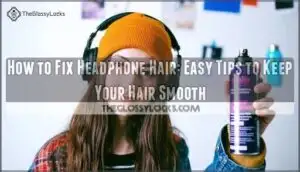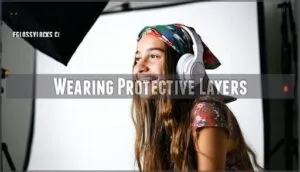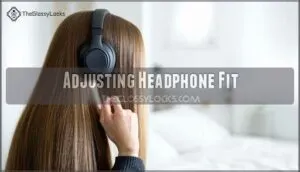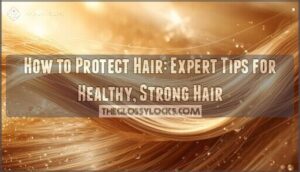This site is supported by our readers. We may earn a commission, at no cost to you, if you purchase through links.

For persistent cases, use a light mist of water mixed with leave-in conditioner, then reshape with your fingers.
You can also flip your head upside down and blow-dry on low heat to restore volume.
Prevention works wonders too—try switching to a looser headband style, wearing your headphones over a beanie, or rotating their position every hour.
A little texturizing spray can be your secret weapon against the dreaded audio groove that’s cramping your style, and with these tips, you’ll be able to prevent and fix headphone hair.
Table Of Contents
- Key Takeaways
- Causes of Headphone Hair
- Fixing Headphone Hair
- Preventing Hair Damage
- Hair Care and Styling
- Alternative Solutions
- Frequently Asked Questions (FAQs)
- Can you fix headset hair?
- How to treat hair loss from headphones?
- Why does my hair look thin after wearing headphones?
- Can changing shampoo types affect headphone hair?
- Does the weather impact how headphone hair forms?
- Can dietary changes reduce susceptibility to headphone hair?
- How does headphone weight relate to the severity of headphone hair?
- How long does headphone hair typically last?
- Can certain hair products worsen headphone hair?
- Do wireless headphones cause less hair damage?
- Conclusion
Key Takeaways
- You can quickly fix headphone hair by dampening your hands with water and running them through flattened areas, or using a light mist of water mixed with leave-in conditioner to reshape your hair.
- Your hair type determines susceptibility to headphone dents—straight hair shows dents easily while curly hair is more forgiving, so adjust your prevention strategy accordingly.
- Take regular breaks every 30 minutes when wearing headphones to relieve pressure, boost circulation, and give your hair time to recover from compression.
- Consider alternatives like earbuds, bone-conduction headphones, or hair-friendly headphone styles that sit behind the neck to eliminate headphone hair completely.
Causes of Headphone Hair
Headphone hair happens when the band presses on your hair, leaving dents and flat spots that refuse to budge.
Your hair’s texture and style play a big role too—fine or thick, no strand is truly safe from the headphone trap!
Pressure From Headphone Bands
Headphone bands can cause annoying hair flattening and dents by pressing too hard on your scalp.
Headphone bands pressing too hard can leave stubborn dents and flatten your hair, turning your style into a battle to fix.
This headband pressure might leave you with a stubborn case of "headphone hair."
It’s not just cosmetic—tight bands can irritate your scalp or even lead to traction alopecia over time.
One potential factor is lack of moisture, which can exacerbate hair damage from pressure.
Loosen your headphone fit to prevent hair dents and discomfort!
Hair Structure Sensitivity
Pressure impacts your hair’s structure because it’s surprisingly sensitive; even sturdy strands aren’t immune. Over time, trapped headbands can cause temporary changes or even permanent damage.
Want smoother hair?
- Pick lightweight headphones to ease strain.
- Use a volumizing spray for dent recovery.
- Massage your scalp daily for hair health.
- Condition regularly to boost resilience.
Hairstyle and Hair Type Susceptibility
Your haircut and hair type play a major role in how much your hair resents your headphones.
Straight hair easily shows dents, while curly locks are more forgiving. Thicker hair may resist, but fine hair isn’t so lucky.
Protective hairstyles like buns or braids help, but pairing your favorite style with a looser headphone fit works wonders.
| Hair Type | Impact Level | Suggested Hairstyles | Headphone Style |
|---|---|---|---|
| Straight | High | Loose buns, ponytails | Fabric-covered bands |
| Curly | Low | Braids, natural volume | Lightweight over-ear |
| Thick | Medium | High buns, layers | Padded, adjustable designs |
| Fine | High | Short cuts, pixies | Winged headphones |
Fixing Headphone Hair
Tired of that funky dent after wearing headphones? Don’t worry—there’s a headphone hair remedy for everyone.
Start with a quick restyling: spritz a little water on the dent, then finger-comb or use a brush to smooth things out. If you’ve got hair products handy, like a volumizing mousse or texturizing spray, they’re lifesavers for restoring shape.
For a creative disguise, throw on a hat or headband—it’s a classic headphone hair hack that works in seconds. Want to fix hair after headphones with zero fuss? Keep a small bottle of leave-in conditioner at your desk.
If all else fails, changing your hairstyle impact works wonders—looser looks or casual waves mask dents beautifully. For stubborn cases, consider that you can add hair extensions for instant volume. For stubborn cases, consult a professional stylist!
Preventing Hair Damage
You don’t have to choose between great music and healthy hair.
With a few smart tweaks, like lighter headbands and regular breaks, you can keep your locks smooth and damage-free.
Choosing Lightweight Headbands
Material matters in the context of headphone hair prevention.
Lightweight headphones with fabric-wrapped headbands are your best bet for comfort and style.
Consider fabric headphone options for maximum comfort.
Look for adjustable bands and soft fabrics that reduce pressure while keeping your hair dent-free.
Comfort features like wider bands help distribute pressure evenly—a simple headphone hair fix that works without flipping your look into “just got out of bed” mode.
Wearing Protective Layers
Layering up can work wonders for headphone hair prevention.
A thin, soft bandana or lightweight hat materials like cotton or silk create a barrier that cushions your hair.
Choose appropriate bandana thickness for comfort and headphone compatibility.
Many people buy a bandana for hair to protect their hair.
This simple headphone hair fix keeps your hair dent-free and also offers protection from hair damage, proving layering benefits beyond style!
Adjusting Headphone Fit
Nailing the perfect headphone fit doesn’t have to be a headache.
Focus on:
- Comfort Prioritization: Adjust the band so it’s snug but not tight.
- Pressure Distribution: Evenly position the headband across your scalp.
- Fit Customization: Use sliders or padding for better stability.
- Headphone Size Matters: Choose models that fit your head properly to reduce unnecessary headphone pressure and hair dents.
Taking Regular Breaks
Adjusting your headphones is great, but pairing it with regular breaks is even better for headphone hair solutions.
Take a break every 30 minutes for pressure relief and a circulation boost.
Comb through your hair or massage your scalp to speed up hair recovery.
To help strands recover, consider gentle detangling methods.
These headphone breaks aren’t just for comfort—they’re a game changer for headphone hair prevention!
Hair Care and Styling
You don’t need to let headphone hair ruin your style—simple care and smart products can keep it under control.
Keeping your hair hydrated, avoiding tight hairstyles, and treating your scalp to a relaxing massage can make a huge difference.
Maintaining Hair Hydration
Keeping your hair hydrated is like giving it a spa day—it thrives with love.
Use hydration products containing humectants like aloe vera or glycerin, and don’t skip conditioning treatments to lock in moisture.
To maintain ideal hair health, explore specialized hydration solutions.
Drink more water; your scalp health depends on it, and this will help your hair resist headphone hair better, making this one of the easiest hair care tips you’ll actually enjoy.
Avoiding Tight Hairstyles
Tight hairstyles like ponytails can make headphone hair worse by pulling on delicate strands.
Give your scalp some breathing room with these tips:
- Opt for loose buns or braids to maintain hairstyle freedom.
- Try gentle styles that minimize tension and protect scalp health.
- Avoid pulling your hair too tight to prevent dents and discomfort.
These tips aim to reduce the strain on your hair and scalp, promoting a healthier approach to styling by minimizing tension and protecting scalp health.
Regular Scalp Massages
Massaging your scalp isn’t just relaxing—it’s a secret weapon against headphone hair.
Massaging your scalp boosts circulation, reduces stress, and tames headphone hair—your ultimate fix for dents and kinks!
Use circular massage techniques to boost circulation and encourage hair growth. It’s like a workout for your scalp, reducing stress while promoting scalp health.
Add a lightweight oil for extra care. A quick five-minute hair massage is top-tier hair care, helping tackle dents and kinks effortlessly, and can be considered a workout for your scalp.
Alternative Solutions
If you’re tired of wrestling with headphone hair, it’s time to switch things up with smarter options.
From earbuds to hats, there are plenty of simple fixes to keep your hair looking great.
Using Earbuds or Bone-Conduction Headphones
Switching to earbuds or bone-conduction headphones might be your golden ticket to prevent headphone hair.
Earbud benefits include portability and minimal hair disruption, while bone conduction tech delivers decent sound quality without flattening your style.
Comfort comparison varies, but these are lightweight lifesavers.
They’re solid headphone hair solutions—less mess, more freedom.
Bonus: prices now suit every budget!
Wearing Hats or Headbands
Sometimes, a hat or headband can be your secret weapon against headphone hair. They add a barrier between your hair and the headphone band, keeping your style intact.
- Soft Hat Material: Prevent dents and maintain comfort.
- Adjust Headband Thickness: A wider band spreads pressure evenly.
- Ensure Secure Fit: No awkward slips.
- Consider Hairstyle Compatibility: Works best with simple styles.
- Distribute Pressure: Save your scalp from strain.
Changing Headphone Placement
If hats don’t suit you, consider tweaking your headphone placement to prevent headphone hair.
Shift your headphones frequently—try behind-the-head or even around the neck positions for better pressure distribution.
This headphone hair hack keeps your style intact and avoids dents.
Alternating positions isn’t just practical; it’s like giving your hair a break from the heavy lifting!
Considering Hair-Friendly Headphone Styles
In the context of beating headphone hair, choosing the right style is key. Think smarter, not harder:
- Opt for over-ear advantages—extra comfort, less creasing.
- Explore behind-neck options to keep hair dent-free.
- Try clip-on styles or sports headphones for zero headband fuss.
- Wing designs? They lightly float, leaving your hair’s vibe intact.
For quick fixes while traveling, consider using compact travel hair dryers. Your hairstyle for headphones has never been easier!
This approach helps you maintain your hairstyle with minimal fuss and ensures you can enjoy your music without worrying about your hair, making it a smarter choice.
Frequently Asked Questions (FAQs)
Can you fix headset hair?
Yes, you can definitely fix headset hair.
Dampen your hair slightly, use a volumizing spray, and style with your fingers.
For a quick fix, try running a wide-tooth comb through those flattened areas.
How to treat hair loss from headphones?
Like a garden needing tender care, your stressed scalp deserves attention.
Rotate headphone position regularly, use padded headbands, take frequent breaks, and consider hair-friendly alternatives like earbuds to prevent traction alopecia and stimulate recovery.
Why does my hair look thin after wearing headphones?
Headphones flatten your hair by applying pressure, causing temporary compression that makes your locks appear thinner.
The weight redistributes your hair’s volume and can create noticeable dents where the band sits, which is a complete concept related to the effects of wearing headphones.
Can changing shampoo types affect headphone hair?
Certain shampoos with volumizing or texturizing properties can help resist flattening from headphone pressure.
Moisturizing formulas keep hair resilient, while lightweight options won’t weigh down strands that are prone to denting.
Does the weather impact how headphone hair forms?
Weather absolutely impacts headphone hair formation.
Humidity makes your hair more susceptible to dents, while dry conditions can create static that worsens the problem.
You’ll notice more severe headphone marks on rainy or muggy days, which can be attributed to the humidity.
Can dietary changes reduce susceptibility to headphone hair?
Coincidentally, what you eat does influence your hair’s strength and resilience.
You won’t eliminate headphone hair through diet alone, but foods rich in protein, biotin, and omega-3s can make your hair less prone to denting.
How does headphone weight relate to the severity of headphone hair?
Heavier headphones apply more pressure to your hair, creating deeper dents and more noticeable flattening.
You’ll experience less severe headphone hair by choosing lightweight models that don’t press as firmly against your scalp, which can lead to a more comfortable listening experience with lightweight models.
How long does headphone hair typically last?
Like a temporary wrinkle in fabric, your headphone hair typically vanishes within 30 minutes to a few hours.
It’ll disappear faster if you dampen your hair or use styling products to reset it.
Can certain hair products worsen headphone hair?
Yes, heavy gels and waxes can make headphone hair worse by creating deeper indentations.
You’ll get better results with lightweight mousses or flexible-hold sprays that allow your hair to bounce back easily.
Do wireless headphones cause less hair damage?
Wireless headphones can still cause hair dents, but they’re typically lighter and exert less pressure on your hair.
You’ll notice reduced damage compared to their bulkier wired counterparts, especially with newer lightweight designs.
Conclusion
Banishing the notorious hair indent doesn’t have to be a headache!
With these simple techniques on how to fix headphone hair, you’ll never stress about audio-induced hairstyle disasters again.
Whether you’re dampening those stubborn dents, using texturizing spray as your secret weapon, or preventing problems with protective layers, you’ve got options.
Remember, a little prevention goes a long way—so adjust your habits now, and you’ll enjoy both crystal-clear sound and flawless locks without compromise.
- https://lifehacks.stackexchange.com/questions/1751/how-to-reform-dent-on-hair-due-to-long-usage-of-head-phones
- https://www.gq.com/story/how-to-fix-headphone-hair
- https://www.reddit.com/r/LifeProTips/comments/1snvvc/lpt_request_how_to_avoid_headphone_hair/
- https://www.head-fi.org/threads/headphone-hair-how-to-deal-with-it.288483/
- https://linustechtips.com/topic/879567-what-do-you-do-to-stop-from-getting-headset-hair/










